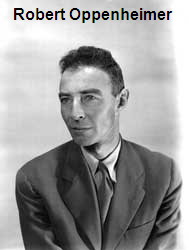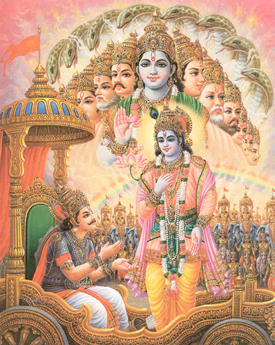‘I am Time grown old to destroy the world ...’

 On July
16, 1945, Robert Oppenheimer was face down in the dirt outside the control
bunker at Trinity, now known as White Sands, New Mexico. The event was the
successful testing of the first atomic bomb. The charismatic and brilliant
physicist Oppenheimer, the leader of the now infamous Manhattan Project, lay
10,000 yards south of ground zero.
On July
16, 1945, Robert Oppenheimer was face down in the dirt outside the control
bunker at Trinity, now known as White Sands, New Mexico. The event was the
successful testing of the first atomic bomb. The charismatic and brilliant
physicist Oppenheimer, the leader of the now infamous Manhattan Project, lay
10,000 yards south of ground zero.
The sight of the terrible apparitional mushroom cloud climbing into the heavens made Oppenheimer remember a line from the Bhagavad Gita: ‘Now I am become death, the destroyer of the worlds’ (BhG.XI.32).
According to Oppenheimer himself, the Bhagavad Gita was a primary source of his philosophical views. His considerable genius included an amazing facility for languages and in his 20s, he quickly learned Sanskrit. He kept the Gita on the bookshelf nearest his desk and gave copies away to his friends as gifts. Oppenheimer said that the Bhagavad Gita was ‘the most beautiful philosophical song existing in any known tongue.’ (Bird & Sherwin) If Oppenheimer had gone a bit deeper than mere philosophy, perhaps his life would not have become so tragic.
Erwin Schrodinger
The Austrian physicist Erwin Schrodinger was also profoundly influenced by Vedic thought. As the father of quantum mechanics and of Schrodinger’s Cat fame, he ‘devised the wave equation every quantum system must obey’ and represented ‘quantum stuff as a waveform’ (Nick Herbert). Schrodinger kept copies of the Sanskrit texts of the Bhagavad Gita and Upanishads by his bed.
Would modern science have ever embraced quantum physics without Schrodinger’s understanding of Vedic thought? Subhash Kak, both a scientist and an Indologist, has written on Schrodinger’s involvement in Vedanta suggesting how modern thought has been influenced by Vedic traditions. Professor Kak tells us that: ‘… before he [Schrodinger] created quantum mechanics, he expressed his intention to give form to central ideas of Vedanta, which, therefore, has had a role in the birth of quantum mechanics.’
Oppenheimer’s translation of the verse spoken during the Vision of the Cosmic Form is, ‘Now I am become death, the destroyer of worlds.’ The great Kashmir Saivite, Abhinavagupta translates this as, ‘I am the powerful time, instrumental in the destruction of the world’ (B.Marjanovic).
कालो ऽस्मि
लोकक्षयकृत् प्रवृद्धो
लोकान्समाहर्तुमिह
प्रवृत्तः
.
ऋते ऽपि
त्वां
न
भविष्यन्ति
सर्वे
ये ऽवस्थिताः
प्रत्यनीकेषु
योधाः
.. ११-
३२..
kālo 'smi lokakṣayakṛt pravṛddho
lokān samāhartum iha pravṛttaḥ
ṛtepi tvāṃ na bhaviṣyanti sarve
yevasthitāḥ pratyanīkeṣu yodhāḥ 11.32
 The
Sanskrit word used here is kAla, with a diacritical ‘long mark’ over the first
‘a’, not the second ‘a’; and its definition in the M.Monier-Williams Sanskrit
to English dictionary is: ‘a fixed or right point of time, a space of time,
time in general.’ The dictionary goes on to enumerate various nuances of the
word kAla as ‘measure of time, death by age; time leading to events, the causes
of which are imperceptible to the mind of man; destiny, fate; time as
destroying all things; death, time of death.’
The
Sanskrit word used here is kAla, with a diacritical ‘long mark’ over the first
‘a’, not the second ‘a’; and its definition in the M.Monier-Williams Sanskrit
to English dictionary is: ‘a fixed or right point of time, a space of time,
time in general.’ The dictionary goes on to enumerate various nuances of the
word kAla as ‘measure of time, death by age; time leading to events, the causes
of which are imperceptible to the mind of man; destiny, fate; time as
destroying all things; death, time of death.’
The word kAla encompasses the idea that Time and Death are inextricably woven together. This complexity of deeper meanings here gives us some insight into the complicated intricacies of Sanskrit and the reason why there are so many various translations of the Bhagavad Gita and other texts.
The Indian scholar M.N.Dutt also translates the word kAla as Death. The translation by Swami Gambhirananda is: ‘I am death, the Destroyer of all, who have grown in stature. I have now become active for devouring people.’ Remember that the Vision of the Cosmic Form (XI.25-27) shows the warriors being crushed by tusk-like teeth!
Centuries of Indian Tradition
I don’t believe a westerner can absorb the centuries of Indian tradition that one who has grown up breathing and living, immersed in this atmosphere will acquire naturally. Do most Indians simply know that Death and Time are functioning as one entity because Time destroys all things? We make no such connection here in the west. There is no concept of Time as the Destroyer, except perhaps to the very old. We actually say - time is money! Surely all Hindus are familiar with the theory of the Cycles of Time.
Winthrop Sargeant translates the verse as ‘I am Time, the mighty cause of world destruction, who has come forth to annihilate the worlds.’ And my favorite is that of J.A.B.van Buitenen:
I am Time grown old to destroy the world,
Embarked on the course of world annihilation.
Krishna is an expression, an incarnation and avatar, of Vishnu’s promise to sustain the world by restoring the balance between good and evil. Time is the force that envelopes us all. Time is an atmosphere, setting and habitat, the invisible medium that permeates Space and allows the Matrix to exist.
Time moves in cycles and when the forces of darkness are overrunning the world, Time becomes ripe for the rebalancing of the world. Time ‘embarks on the course’ to annihilate and devour the imbalance. As the Dvapara Yuga draws to a close, Krishna and Arjuna are the instruments of this cyclical process.
The Cycles of Time
To understand this verse, the reader needs to have some understanding of the theory of the Cycles of Time in Hinduism. The 4 Ages are:
1. The Satya or Krita Yuga, a Golden Age
2. The Treta Yuga, the Age of Ritual
3. Dvapara Yuga, the Age of Doubt: Man loses the sense of the
divine reality of the world and grows away from natural
law
4. The Kali Yuga, the Age of Conflict and confusion began in
3012 BC and will end with the nearly total devastation of
the present humanity
In Hindu metaphysics time is cyclical and each period of manifestation is called a KALPA of Brahma, equivalent to 4.32 billion human years.
The KALPA is subdivided into 14 MANVANTARAS.
We are now in the seventh MANVANTARA of this KALPA.
Each MANVANTARA is divided into 71 MAHA-YUGAS of 4,320,000 years each.
We are in the 28th MAHA-YUGA of this MANVANTARA.
Each MAHA-YUGA is made up of four yugas
Each Yuga is preceded by a period of a dawn and followed by a period of twilight. [Linga Purana 1.4.3-6]
When you study the Hindu theory of the Cycles of Time and the Yugas, you will find a confusing divergence of opinion concerning the dates of their duration. Considering that we are now living in the Age of Confusion, the Kali Yuga, it is not surprising to find so much disagreement on these matters.
What is more important to me than precise numbers is the fact that we are living in an era where there is almost no memory of the previous cycles of time. Most of us wrongly believe that civilization begins with written history, but writing is actually the symptom of a degenerative culture. It is sound that communicates meaning, not the markings that seek to represent it.
Reach beyond the limited frequencies of this Veil of Illusion you have been confined within all of your life. The experience of expanding and projecting your thoughts, consciousness, and imagination back into primordial time is in itself liberating, revealing, and uplifting.
The Duration of Time as a Function of Consciousness
The realization that time is in fact a function of consciousness will alter your perception of reality. We all experience time relative to our own specific consciousness in any given moment. You can verify this for yourself by simply reflecting on, for example, how time flies when you are happy - as opposed how time drags when you are stuck in traffic or heart broken.
Another example would be to consider the frenzied consciousness of an ambitious ‘type-A’ personality. The would-be-executive runs around nonstop day after day, balancing a bazillion enterprises in order to gain money, prestige and power, keeping busy-busy-busy, and avoids any possible solitude or contemplation.
Compare this with the consciousness of a Tai Chi Master who moves so slowly as to defy nature and yet can knockout his opponent from across the room, or an ascetic hermit yogi who never moves, never goes anywhere or does anything - but by remaining at the center of his being, becomes One with the Universe.
Time does not exist outside the temporal illusory hologram
All increments, meaning measurements of time and space, are relative to the consciousness of the perceiver and thus the product of variations in waveform frequencies, based on and the result of the specific degree of the illusion of Separation from Oneness.
This is similar to the quantum physics theory, The Copenhagen interpretation, Part II: Reality is created by observation. Or you might say more accurately, reality is created by the consciousness of the observer.
In ‘While the Gods Play’, the French scholar Alain Danielou explains that the length of a moment is established by the rhythms of consciousness that perceive it:
It is energy, by producing vibratory waves having direction and length, that will give birth to the rhythms whose perceptions will create the dimension of time, the measure of space, and at the same time the structures of matter.
For man, the perception of the dimension of time is determined by his vital rhythms, his heartbeat…
The relative duration of each of the four Yugas is 4:3:2:1. This implies that the Golden Age is the longest and our current Kali Age is the shortest. My understanding is that time actually continues to speed up in the Twilight of the Kali Yuga and increases ever more so, as we reach the end. The Cycles of Time are comparable to classical Indian Ragas that begin slowly, serene; increase in tempo and passion, and end in a frenzy of energy.
The Kali Yuga began in 3606 BC
Alain Danielou’s dates differ from others, but somewhat agree with the Mayan Calendar and the Hopi predictions. Danielou says that the Kali Yuga began in 3,606 BC and most scholars also do agree with this date. However he gives the duration of the Kali as 6,048.72 years.
Danielou says that the Twilight of the Kali Yuga began in 1939 with the discovery of atomic fission. According to him, the final catastrophe will take place during this twilight and the last traces of this present mankind will have disappeared in 2442.
The fact that this date of 1939 coincides with the discovery of atomic fission curiously fits in rather well with Oppenheimer’s recalling the verse from the Bhagavad Gita at the moment of the explosion of the first atomic bomb.
With or without Arjuna
 Krishna
tells Arjuna that this cyclical cleansing will take place with or without him.
Arjuna’s choice to fight or not is irrelevant in the grand cosmic scheme
(XI.32). The enemy now awaiting battle on the fields at Kurukshetra, the
thousands who are arranged in formation, arrayed (avasthitah) in chariots, on
horseback and high upon elephants, will each one cease to exist (na
bhavisyanti).
Krishna
tells Arjuna that this cyclical cleansing will take place with or without him.
Arjuna’s choice to fight or not is irrelevant in the grand cosmic scheme
(XI.32). The enemy now awaiting battle on the fields at Kurukshetra, the
thousands who are arranged in formation, arrayed (avasthitah) in chariots, on
horseback and high upon elephants, will each one cease to exist (na
bhavisyanti).
... of all these hosts of hostile chiefs arrayed
There stands not one shall leave alive the battlefield!
- Ganguli
Krishna is essentially telling Arjuna that his involvement here ‘counts for nothing’ (Gambhirananda). With the Vision of the Cosmic Form still looming high above them, Krishna encourages Arjuna, perhaps commands him to stand up and defeat his enemies (satrun) - who have already been killed by Vishnu. Arjuna is only the chosen instrument (XI.33)
Dismayed No longer be!
Arise! obtain renown! destroy thy foes!
Fight for the kingdom waiting thee when thou hast vanquished those.
By Me they fall - not thee! the stroke of death is dealt them now,
Even as they show thus gallantly; My instrument art thou!
- Ganguli
Krishna assures Arjuna of victory and urges him to go forward into battle and to kill even those men, Bhishma and Drona, who were once his beloved teachers (XI.34). Arjuna’s love for and memory of these two men has made him falter, but they have joined the enemy. Bhishma and Drona have unwittingly become the servant of the darkside, the demonic. Arjuna cannot fail, for these hundreds of thousands of warriors are as good as dead now. They have already been slain (hatan) by Vishnu acting through Krishna.
Abhinavagupta’s commentary (B.Marjanovic) reflects the higher meaning. The Vision of the Cosmic Form is the manifestation of consciousness in this universe. It is consciousness itself that will devour it’s own polarities, knowledge and ignorance, light and dark in the temporal illusory hologram. This must occur in some manner at the close of every Yuga in every Manvantara - world without end!
Arjuna on his knees ...
The Vision of the Cosmic Form has left Arjuna terrified and trembling. Perhaps this is why such visions are so hard to come by; they would overwhelm even the greatest bravest warrior in the world. Arjuna humbly gets down on his knees and in reverence acknowledges what he has seen as the Lord of all Lords, the Great Self (mahatman) and the original cause (adi katre). He praises Krishna (XI.35-40).
For Thou art, now I know,
Father of all below,
Of all above, of all the worlds within ...
Again, Thou God! again
A thousand thousand times be magnified!
Honour and worship be -
Glory and praise, - to Thee
Namo, Namaste, cried on every side;
Cried here, above, below,
Uttered when Thou dost go,
Uttered where Thou dost come! Namo! we call;
Namostu! God adored!
Namostu! Nameless Lord
Hail to Thee! Praise to Thee Thou One in all
For Thou art All!
- Ganguli
Arjuna then apologizes to Krishna for any impulse, any offense he may have given in jest or affection in the course of their ordinary friendship when he thought of Krishna as only a man. He then begs Krishna to return to his familiar human form (XI.45-46), to change from that terrifying divine form with one thousand (sahasra) arms back into the familiar one, as most translations say, with four arms (caturbhujena)!
Let me once more behold
The form I loved of old,
Thou of the thousand arms and countless eyes!
This frightened heart is fain
To see restored again
My Charioteer, in Krishna's kind disguise.
American Prometheus
The Triumph & Tragedy of J. Robert Oppenheimer
Kai Bird & Martin J. Sherwin
Alfred A. Knopf, 2006, New York
While the Gods Play: Shaiva Oracles & Predictions on the Cycles of History and the Destiny of Mankind
Alain Danielou
Inner Traditions, 1987
Quantum Reality: Beyond the New Physics
Nick Herbert
Anchor Books/Random House; 1985, New York
Photographs of the quite handsome Schrodinger & quotations:
www.spaceandmotion.com/quantum-theory-erwin-schrodinger-quotes.htm
Computing Science in Ancient India
T.R.N. Rao & Subhash Kak
Munshiram Manoharlal Publishers Pvt. Ltd.; 2000, New Delhi
The Uddhava Gita, The Final Teaching of Krishna
Translated by Swami Ambikananda Saraswati; 2002, Ulysses Press
The VAYU Purana
Translated and Annotated by Dr. G.V. Tagare
Part I & II
Motilal Banarsidass Publishers; 1987 & 2003, Delhi
The LINGA Purana
Translated by a Board of Scholars and Edited by Prof. J.L. Shastri
Part I & II
Motilal Banarsidass Publishers; 1973 & 1997, Delhi
Cosmic Day of Brahma the Creator -The Hindu Concept of Time
geocities.com/Athens/Rhodes/2952/gohitvip/41.html
